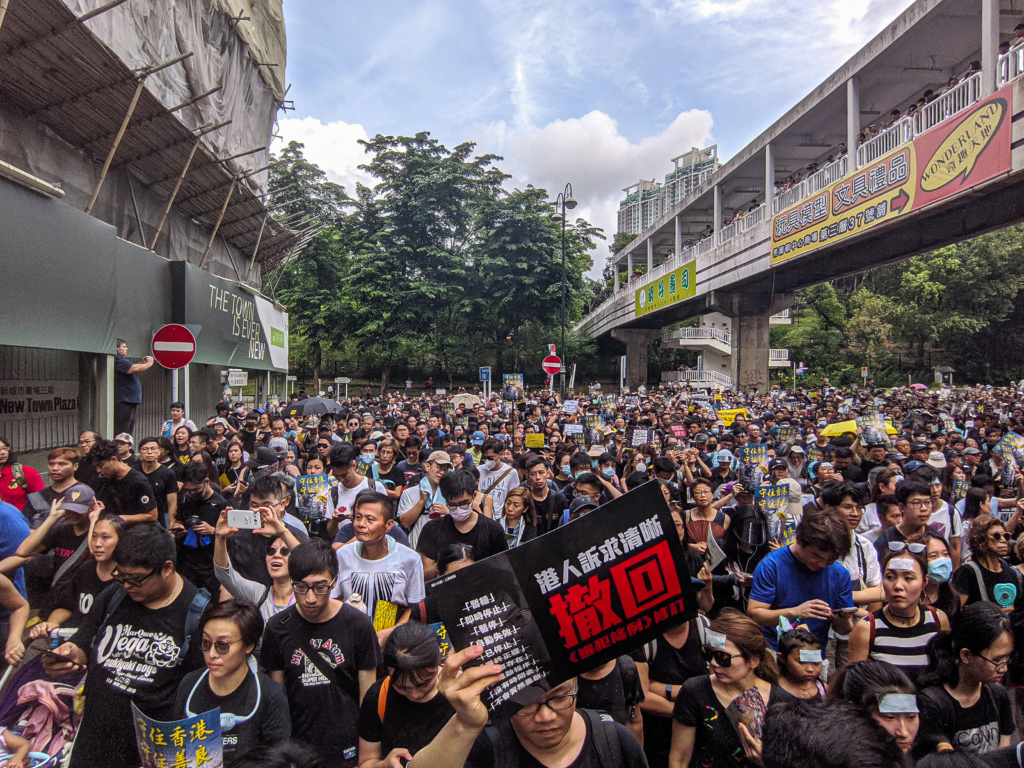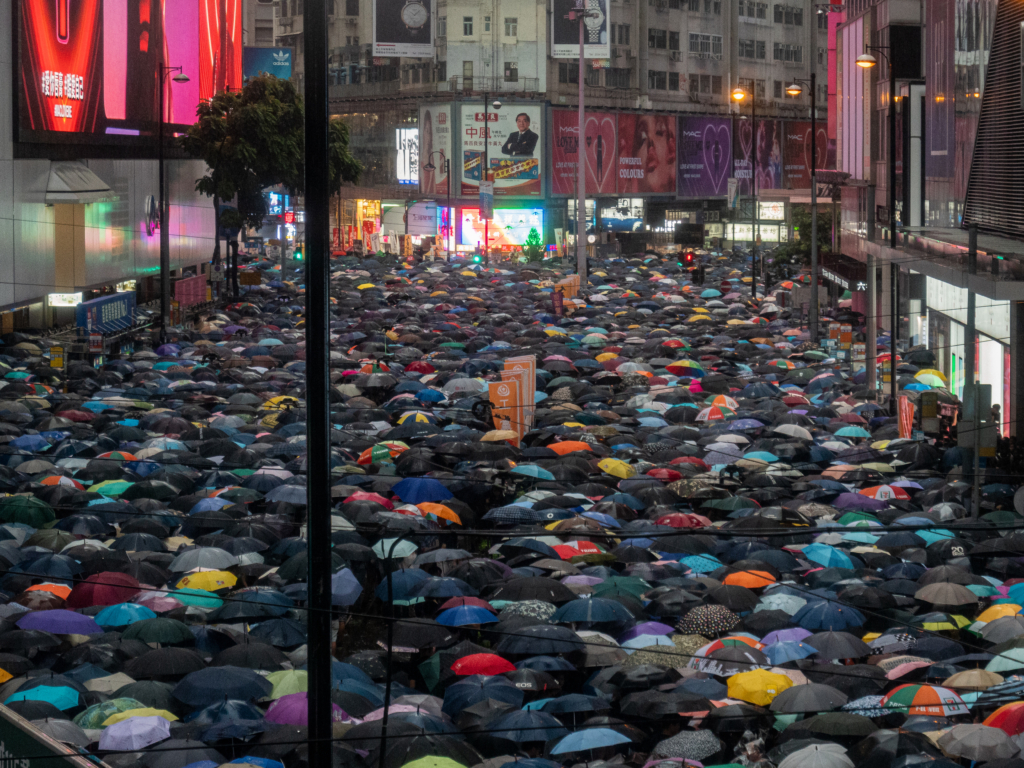by Henry Su

For 14 weeks, the people of Hong Kong have donned masks, goggles, and umbrellas and taken to the streets of the city in protest. Each week, news about the protest reaches the international spotlight, and especially in recent weeks, has gained the attention of celebrities, diasporic communities of Hong Kongers and sympathetics, and public officials. President Trump on the 15th of August even commented on the protests, urging the people of Hong Kong to meet with Chinese premier Xi Jinping to negotiate. The amount of unrest and attention over the entirety of the spring and summer illustrate the scale and significance of protests that are far removed from most American minds, but that allude to a global issue that has erupted in large scale violence in the past century.
The beginning of the issue can be traced back to 1997, when on July 1, Hong Kong was handed over from the United Kingdom’s rule to China in a historic ceremony ending 156 years of colonial rule. China then designated Hong Kong as a “special administrative region”, which does not adhere to the policies of the central government of China, and is in most senses, an autonomous body. Many Hong Kongers at the time feared sweeping restrictions on personal freedoms as democratic life under the British transitioned into centralized communism under China’s CCP. The government, previously functioning as a British-appointed crown colony, became one appointed by the CCP. Although the government functions representatively, the elected Chief Executive is approved by the Premier of China. Because of this, the Council of Hong Kong is largely under the jurisdiction of China and is made to adhere to the State’s agenda, while simultaneously enjoying freedoms such as limited elections that people in the PRC do not enjoy.
China indicated in 1997 that the integration of Hong Kong would not be instantaneous, and rather would take place over the coming decades. Gradually, throughout the 2000s, the CCP began asserting its control over the Hong Kong SAR while benefiting from a closer economic relationship. Hong Kong is a world financial center, and much foreign trade and banking conducted in the Sinosphere is through the Hong Kong conduit. Meanwhile, in Hong Kong, tensions began rising as residents began to feel the influence of communist policy on their democratic system.
These underlying tensions came to a head in September 2014, when the CCP proposed reforms to the HK government which many viewed as extremely restrictive to democracy, and allowing “too much” control by the Party over elected officials. This led to a three-month period of protests called the Umbrella Movement, in which over 100,000 people, mostly young college students, crowded the Central District and key areas of the city and rallied for change. The movement was incited as a call for full suffrage for all citizens to return to Hong Kong, and many young people, who were previously politically uninvolved, joined in protest and became activists. The protests ended with the withdrawal of the proposed changes in December, and in the duration of the protests, thousands of people were arrested and numerous scuffles between protesters and police occurred. Many citizens saw tear gas and aggressive subduing force used by the police as excessive, and resentment towards the police force grew over time. Several protest groups named the HK police as tools for the CCP to enforce laws by force over the people. Many Hong Kongers have a distinct memory of the 1989 Tiananmen Square massacre that mainland Chinese do not, so the possibility of police violence and Chinese strong arming is very real to many. Like the Arab Spring three years before, the protests were captured on smartphones and broadcasted around the world on social media. Because of this coverage, the protests received a high degree of media attention around the world. President Obama ceded to Premier Xi in a 2014 meeting that the United States was “not involved” in the protests, while being warned by the Chinese not to interfere. Although protests concluded, many young people in Hong Kong felt wronged by the Chinese government and neglected by Western democracy, and anti-communist sentiment continued to rise into the late 2010s.

Source: Pete Souza/ White House
In February 2019, four and a half years after the Umbrella Movement’s conclusion, China’s NPCSC (Standing Committee of the National People’s Congress) introduced new legislation to the Hong Kong Legislative Council, headed by Chief Executive Carrie Lam. The bill called for the establishment of a policy of extradition, where people breaking Chinese laws in Hong Kong could be extradited, or transported to, China for criminal trial. Many people in Hong Kong saw this bill as a major step towards Chinese assuming control over the region, and Executive Lam’s unwillingness to oppose the legislation sparked public outrage. Once again, people took to the streets en masse, this time dwarfing the numbers of 2014’s crowds, totaling over one million in attendance on June 9th’s march. Even though one in seven people in the city turned out to the day of the protest, it remained largely peaceful and the scuffles present in 2014’s demonstrations were avoided. Even so, a few days later, on the 12th, violence erupted between police and protesters. Many eyewitnesses claimed excessive police use of force, and videos on social media of police beating unarmed protesters surfaced the next day. Suddenly, on the 15th of June, Executive Lam announced the suspension of the bill from the legislature. Even with a concession made that was previously unprecedented, the people were still unsatisfied, many calling for the complete withdrawal of the bill altogether. However, the government was unwilling to back down, and so protests began to escalate.
The day after the announcement, the 16th, marked a record 2 million protesters filling the main avenues of the Central District. During the escalation of the protests and breakouts of violence and arrests, the protesters employed a variety of methods to remain unified: Umbrellas, held by protesters, shielded others from identification by media or police. Masks and goggles, donned to protect against pepper spray, also obscure protesters’ identities. Protesters occupy key government offices, and in an incident on the 5th of July, storm the Legislative Council building and vandalize the property. Arrests are made, but the break-in is enough to suspend actions of the Council for some time. Protesters in the streets carry traffic cones and water bottles to snuff out tear gas. Pro-democracy graffiti appears all over the walls of the city. And during the increasing chaos, the police began to respond with brutal mass crackdowns.
This time, the people will not concede with the government. There will be no quiet withdrawal.
With the CCP’s condemnation of the protesters as “violent terrorists” in the month of July, several notable incidents of violence take place following. On the 14th, at a shopping center in Sha Tin, police assault peaceful protesters in an effort to clear the line, resulting in dozens of injuries. At a train station in the city, white-shirt wearing armed men assault protesters returning home after a rally. Many suspect the involvement of the HK triad, a mafia-esque crime organization in the city that often enjoy extralegal negligence from the police force. Police, in response to early-August disruptive rallies in subway stations around the city, use beanbag rounds fired from riot control weapons. One young woman is hit in the eye with a round and is blinded, and her story goes viral. She quickly becomes a symbol of police brutality for many protesters. Most recently, in late August and early September, HK police have begun using high-pressure water cannons and even in one case, live weapons to deter protesters. And despite the crackdown, the protests only increase in magnitude.

Photo: Studio Incendo
Civil servants, lawyers, medical professionals, seniors, students, and mothers held independent rallies in solidarity with the protesters, and a citywide strike in August suspends government operations in much of the region. The Hong Kong International Airport’s main terminal was occupied by thousands on August 15, cancelling flights and halting service completely in the airport in a show of strength against oppression. And on August 23rd, in what has become one of the most internationally notable moments of the protest so far, protesters all around the city formed a “human chain” of over 200,000 people stretching over 50 kilometers. The action commemorated the 30th anniversary of the famous “Baltic Way” protest involving 2 million people calling for the disestablishment of the Soviet Union.
Even into the month of September, six months after the beginning of the demonstrations, rallies drawing hundreds of thousands of people take place every weekday and weekend, and life in the city is affected in every way by the protests. Even for people entirely uninvolved in politics, the cries of the young people for democracy are heard loudly and clearly. And while Beijing refuses to back down, and even rallies the military police for action, the protesters remain unafraid. The people of Hong Kong continue to petition international governments for their support. Even the United States, the “city on a hill” of Western democracy, has remained passive in their role. Even as Carrie Lam declared the bill fully withdrawn on September 4, the anger of the citizens has evolved beyond the removal of their rights to self-determination, and become an outcry against police brutality and corruption. The protests will continue, and life in Hong Kong will never be the same. This time, the people will not concede with the government. There will be no quiet withdrawal. And while some view the movement as treading the path to another Tiananmen Square, the young students leading the fight in Hong Kong against China are undertaking the final struggle between freedom and oppression. And while the world is watching, the people who claim freedom as their own fight must choose to act.
